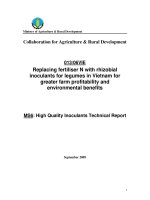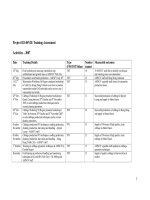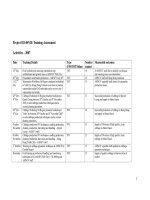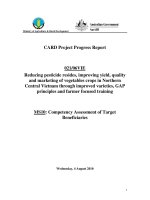Báo cáo khoa học nông nghiệp " PRELIMINARY RESULTS OF DEVELOPMENT BETTER MANAGEMENT PRACTICES (BMPs) FOR INTENSIVE AND SEMI-INTENSIVE BLACK TIGER SHRIMP FARMING IN THE SOUTH VIETNAM " doc
Bạn đang xem bản rút gọn của tài liệu. Xem và tải ngay bản đầy đủ của tài liệu tại đây (94.39 KB, 7 trang )
1
PRELIMINARY RESULTS OF DEVELOPMENT BETTER MANAGEMENT
PRACTICES (BMPs) FOR INTENSIVE AND SEMI-INTENSIVE BLACK TIGER
SHRIMP FARMING IN THE SOUTH VIETNAM
Doan Van Bay, Phan Thanh Lam, Trinh Trung Phi, Nguyen Van Hao
1
Patrick Sorgeloos
2
Abtract
“Development of Better management practices (BMPs) for intensive and semi-intensive black tiger shrimp
farming in the South Vietnam” is carried out with development objectives: “BMPs approach applied is to
increase/improve shrimp production, food safety and environmental protection, and shrimp industry can meet the
growing markets demands in both domestic market and export” and immediate objectives are (1) to reduce the risk
of disease outbreaks and improve the production in shrimp farms; (2) to strength and improve management skills of
the farmers for sustainable production and to quickly meet the growing markets demands; and (3) to produce better
quality of shrimps in socially acceptable, environmentally sound and economically viable manner. The project
duration is 3 years (2008-2010), and it is being jointly implemented by Research Institute for Aquaculture No.2 and
The University of Ghent. To develop and complete a feasible BMPs guidelines and to meet project’s objectives, the
project has 3 specific phases: (1) Phase 1 (10/2007-08/2008): pre-implementation step (pilot farms selection, writing
and completing BMPs guidelines); Phase 2 (09/2008-12/2009): implementation step (BMPs applied in the pilot
farms, monitoring–valuation–adjustments); and Phase 3 (01/2010-12/2010): post-implementation step (BMPs
guidelines completed, development of printed and broadcast material). This project could also provide a model for
addressing sustainability in other aquaculture commodities.
Keywords: Better management practices (BMPs), intensive P. Monodon culture, semi-intensive P. Monodon
culture
1. Introduction and Objectives
Vietnam has the long coast over 3,200 km with characteristics to made territory, climate, water
resource, hydrograph, specially in territory and delta which is evaluated to have a huge potential in
aquaculture with brackish shrimp culture had been selected as a main culture animal, Up to 2007,
total aquaculture production was 2.10 million tons, aqua export return – over was 3.75 million
USD (among top ten aqua export countries in the world), increase 250 times compare with 1981.
In which, shrimp culture was 355,000 tons, export return – over was 1.51 million USD (Dung,
2008). Therefore, brackish shrimp culture has a breakthrough in Vietnam aquaculture history.
After 7 years (2000 – 2007), to change the using of agriculture land by the resolution No.
09/2000/NQ-CP of Vietnam government, brackish shrimp culture got the key position not only
business scale and usefulness of land – water – labor resource but also mobilizing material
resource to develop culture – process – service of brackish shrimp (Phi et al, 2007). Beside
achievements, there are some limits such as (1) Development of brackish shrimp culture is not
sustainable and high rate of risk; (2) Brackish shrimp culture has been a main cause
environmental pollution of soil and water; (3) Achievement of productivity, yield, quality and
export return – over of brackish shrimp are still low, this does not correspond with potential and
advantages; (4) The yield of brackish shrimp in the same model (intensive, semi-intensive,
extensive) has long distance between household, farms and areas in an ecologically area; (5) The
solutions, which increase yield, quality and effect, is still limit; (6) The co-operation between 4
1
Research Institute for Aquaculture No. II (RIA II)
2
Ghent University
2
steps: production – buying – process – consumption does not control closely that reduce the
competition of products on the market; and (7) To guarantee food safety standards for brackish
shrimp is insufficient.
- “Development of Better management practices (BMPs) for intensive and semi-intensive
black tiger shrimp farming in the South Vietnam” is carried out with development objectives:
“BMPs approach applied is to increase/improve shrimp production, food safety and
environmental protection, and shrimp industry can meet the growing markets demands in both
domestic market and export” and immediate objectives are:
- To reduce the risk of disease outbreaks and improve the production in shrimp farms;
- To strength and improve management skills of the farmers for sustainable production
and to quickly meet the growing markets demands; and
- To produce better quality of shrimps in socially acceptable, environmentally sound and
economically viable manner.
2. Materials and Methods
2.1. Pilot farms selection and duration:
- Intensive shrimp farming include: 05 in Soc Trang province, 02 in Bac Lieu province,
02 in Ba ria - Vung Tau province and 01 in Ben Tre province. The scale is from 10 ha to 300 ha.
- Shrimp hatcheries include: 01 in Bac Lieu province and 01 in Ba ria - Vung Tau
province. The scale is from 30 tanks to 50 tanks.
- Duration includes 3 phase: 1) From Oct 2007 to Aug 2008; 2) From Sep 2008 to Dec
2009 and 3) From Jan 2010 to Dec 2010.
2.2. Implementation:
- Phase 1: (Oct 2007 to Aug 2008)
1) Organizing a study tour for farmers to visit the pilot of BMPs application in India and
Thailand.
2) Selecting the growth-out and hatchery farms to participate the project.
3) Writing and completing draft BMPs guidelines.
4) Organizing workshop to improve BMPs guidelines with participation of farmers,
promoters, administrators and institutes.
- Phase 2: (Sep 2008 to Dec 2009)
1) BMPs applied in the pilot farms.
- Training courses on BMPs approach will be given to the pilot farms.
- Farms are re-organized in order to ensure appropriate for BMPs approach.
- Technical training and assistances support for farms.
- Farmers are trained on recording sheets, pond books in order to use for
traceability documents, and solve problems faced through this data sources.
3
2) BMPs for linkage to input suppliers (i.e. fish feed and chemical suppliers). This linkage is
carried out by contracts, mainly quality assurance and food safety in socially acceptable,
environmentally sound and economically viable manner.
3) BMPs approach will be implemented voluntarily by the pilot growth-out and hatchery
farms.
4) Monitoring, valuation and adjustments implementation: Monitoring, valuation and
adjustments activities will be carried-out periodical.
5) Promoting for linkage activities to join the processor, importers and exporter to ensure
out put shrimp framing products.
- Phase 3:
1) To finalize the BMPs guidelines completed will be done.
2) Development of printed and broadcast material.
3) Holding workshop to announce and expand BMPs implementation.
3. Results and discussion
3.1 Writing and completing BMPs guidelines
3.1.1. Phase 1: (Oct 2007 to Aug 2008)
- Organizing a study tour for farmers to visit the pilot of BMPs application: In December
2007, BMPs Project organized a study tour for farmers, who own large-scale with growth – out
and hacheries farms, to visit the pilot of BMPs application in India and Thailand.
- Writing and completing draft BMPs guidelines: From December 2007, base on the
experiences from study tour combine with collected documents and practiced study. The BMPs
Project’s staff has completed the draft BMPs guidelines.
- Organizing workshop to improve BMPs guidelines: In February 2008, the first worshop was
organized in Ho Chi Minh city with participation of farmers, promoters, administrators and
institutes. The workshop collected many ideas to complete BMPs guidelines.
- Organizing workshop to complete BMPs guidelines: base on the first worshop, BMPs
Project’s staff had completed BMPs guidelines in March and April 2008. In May 2008, the
second worshop was organized in Ho Chi Minh city, which focus on completing BMPs
guidelines and planning for activities in 2008. From May to August 2008, the BMPs guidelines
were completed.
3.1.2. Phase 2: (Sep 2008 to Dec 2008)
- Training courses on BMPs approach: In Sep and Oct 2008, trainning course had been given
to the pilot farms.
+ In Sep 2008: Trainning course had been given to the pilot farms in Bac Lieu and Soc
Trang province.
+ In Otc 2008: Trainning course had been given to the pilot farms in Ben Tre and Ba ria –
Vung Tau province.
4
- Monitoring, valuation and adjustments: In October 2008, the workshop was organized on
the farm of Ngan Long Ltd. Company in Ba ria – Vung tau province with participation of Ghent
University, Inve Group, Van Minh AB Ltd. Company, Depatment of Agriculture & Rural
Development of Ba – ria Vung Tau, Bac Lieu. Central of Fisheries Extensive. Though this
workshop, activities of year 2008 and plants of year 2009 was monitored and valuated.
- Information: Imformation about Project was pubshied on RIA 2 news-letter (quarter
II/2008). Project’s staff also participted workshop on “Apply RFID technical in monitoring
process and inquring shrimp products in Quang Ninh” (Aug/2008).
3.1.3. Phase 3: Will be done up to end of 2010
3.2. Contents of BMPs for farming techniques
3.2.1. BMPs for shrimp hatcheries
1) Requirements for site selection
2) Requirements for construction and hatchery building
3) Requirements for water supply management
4) Brood stock management
5) Spawning techniques and nauplius harvesting methods
6) Larvae heath management
7) Larvae feed management
8) Medicine, chemical and pro-biotic management
9) Postlarvae transportation methods
10) Waste water and solid management
11) Disinfection management of the hatchery
3.2.2. BMPs for the growth-out intensive and semi-intensive shrimp farming
1) Requirements for on site selection
2) Requirements for farm construction and building
3) Pond preparation and shrimp crop
4) Seed selection and stocking
5) Feed management
6) Medicine, chemical and pro-biotic management
7) Shrimp pond management
8) Shrimp health management
9) Waste water and solid management
10) Harvesting and post harvesting
3.3. BMPs for farming organization and linkage to local community
5
3.3.1. Requirements for farming organization
1) Requirements for buildings and grounds
2) Requirements for equipment, maintenance and housekeeping
3) Requirements for warehousing in storage
4) Requirements for production records
5) Requirements for personnel management
3.3.2. Linkage to local community
Farm’s operating will influence surrounding communities at various levels. Therefore, it
is important to manage these interactions, and farms have to make co-operated planning and
support programs linked to local community in order to be received their supports as allies to the
production activities
1) To reduce the impact to local community, farms have to do such as.
2) When new aquaculture facilities are planned the surrounding communities must be
informed and they should be provided with an opportunity to voice concerns and support.
3) Whenever possible, new employees should be sourced from the surrounding communities
in preference to importing personnel from further a field in order to solve the
unemployment for the communities.
4) Where possible, contractors should be sourced from local communities when aquaculture
facilities are planned to build or repair.
5) Where practically possible, discounted aquaculture products should be made available to
local communities such as local companies or middle-men requirement.
6) Efforts should be made to encourage aquaculture and environmental awareness by
allowing and facilitating visits by schools and other community groups.
7) Farm’s operating should not prevent interests in resources using of the surrounding
communities, simultaneously farms need to fund for communities development such as to
build house for poor people, to establish educational budget, to re-build bamboo bridge
and to repair the roads.
8) Efforts should be made to encourage environmental awareness of local communities in
the centralization areas by supporting to establish clubs, union, cooperatives, … Farms
should fund to create the risk-budgets soon in order to prevent negative impacts to
surrounding communities when the disease outbreak.
9) The conflicts and complaints from local communities must be received and dealt with
appropriately to ensure due consideration to these problems.
3.4. BMPs for linkage to input suppliers
6
In general aquaculture development and black tiger shrimp in particular, the feed, medicine and
chemical used during cultivating is very important and need to be concern. Besides, the
requirement on production quality of markets is growing quickly, production have to be
produced with high quality and food safety. So to meet the market demands and ensure
sustainable development of shrimp industry, hatcheries and growth-out farms need to linked to
input suppliers (i.e. fish feed and chemical suppliers) with contracts systems. This linkage is for
various benefits, mainly quality assurance and food safety in socially acceptable,
environmentally sound and economically viable manner.
3.4.1. General requirements for co-operation
1) Requirements for hatcheries and growth out farms: 1) Manager of hatcheries and growth
out farms are knowledgeable about the technical specialty, markets and economic law. 2)
Managers frequently update information on the circular, decree, decision involved in
aquaculture development from Government. 3) Managers need to prepare farm’s
documents on status and trends in recent years and potential development. 4) Farms need
to make planning and strategies development annually. 5) Farms have points of view and
strategies more correctly and flexibility to attract supporting from science and input
suppliers. 6) Farms need to know basic history development of input suppliers and their
production sources in quality and traceability documents before signing a contract.
2) Requirements for input suppliers: 1) Manufacturing building, branches, trading stations
are fixedly built and specify address. 2) Suppliers frequently update information on the
circular, decree, decision involved in aquaculture development from Government and
market information on fisheries export. 3) Productions ensured in quality and food safety,
and reached production certification from domestic and international appropriate
authorities. 4) Suppliers need to know basic history development of farms and their
capacity before signing a contract.
3.4.2. Requirements for co-operated procedures
1) Requirements for suppliers’ production: 1) Production has ingredients clearly and label
with specific sources, period of using. Besides, production labels need to show quality,
sources certification and traceability documents. 2) Production ingredients have to ensure
good quality and to follow regulations/criteria on food safety from fisheries authorities.
3) The storage containers and packing are protected from weather damage or
environmental contamination. 4) Ingredients formula are reviewed and tested routinely
for food safety, and plan to adjust appropriately for shrimp seed and growth out farms. 5)
Labels are stored in a manner that minimizes the potential for errors in labeling, it show
clearly ingredients, sources, periods of using and traceability documents.
2) Requirements for conveyances and storage: 1) The conveyances loaded and unloaded
need to be checked in order to ensure clearly labels, structural integrity prior to loading to
minimize the potential for contamination, un-expired date and attached traceability
documents. 2) need to check products packing to ensure safety and in a manner that
minimizes the potential for commingling or cross-contamination. Simultaneously, farms
also check the standardized quantity of products as agreement in contract systems.
7
3) Requirements for trading records: 1) A sample products of trading need to be kept for an
appropriate period (minimum of 3 months suggested) in order to test when facing risk
events. 2) Trading records are retained for an appropriate period (minimum of one year
suggested), and record information on certification code, label code, products sources. 3)
Trading records are reviewed routinely and managed carefully, and are immediately
notified of significant complaint on production quality.
4) Requirements for co-operated documents: 1) Farms and suppliers have to review all co-
operated documents carefully, discuss and agree contract clauses before signing a
contract. 2) The contract systems have to follow guidelines and regulation from
Government.
5) Complaint and recall procedures: 1) Complaints and recall procedures have been
developed and implemented; the procedures include investigation and documentation of
the findings. 2) All complaints/feedback involved in capital, adulterated or unsafe are
notified in a timely manner. Serious consideration is given to notifying appropriate
federal and state regulatory authority.
4. Conclusion and suggestion
BMPs approach, which was completed by partners (the pilot farms in particular), will get
high practicability and feasibility. BPMs application would be effect if it is supervised and
supported perfectly in implementation. BPMs can be a good method need to carry out together to
produce better quality of shrimps in socially acceptable, environmentally sound and
economically viable manner.
5. References
- Nguyen Vu Dung (2008). Achieving a Sustainable Future for Vietnamese Seafood
Industry. Presentation in IIFET 2008 Vietnam: “Achieving a Sustainable Future: Managing
Aquaculture, Fishing, Trade and Development - Nha Trang, Vietnam, July 22 - 25, 2008.
- Trinh Trung Phi, Phan Thanh Lam, Do Quang Tien Vương, Nguyen Duy Hoa, Pham Ba
Vu Tung, Nguyen Van Hao (2007). Planning for development of brackish shrimp culture to 2015
and orientation to the year 2020. Technical Report, RIA 2, Ho Chi Minh city.









